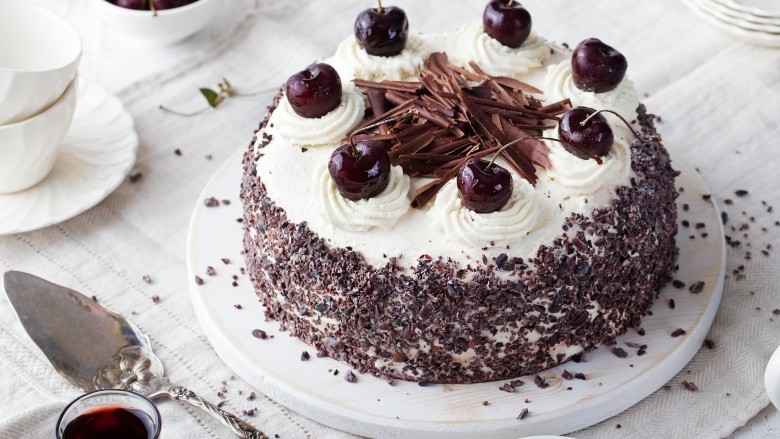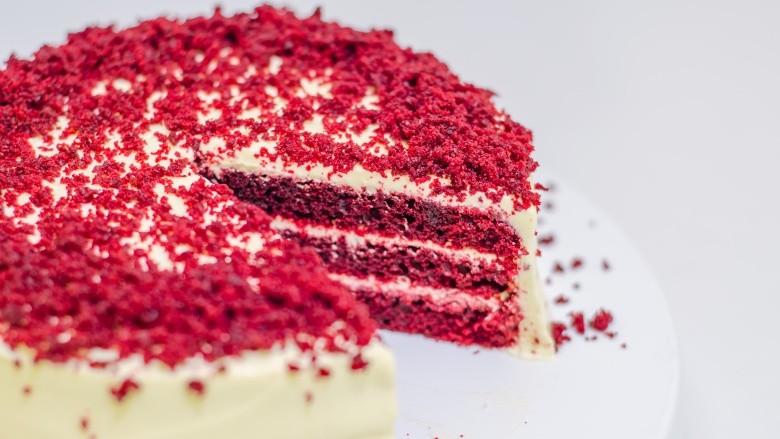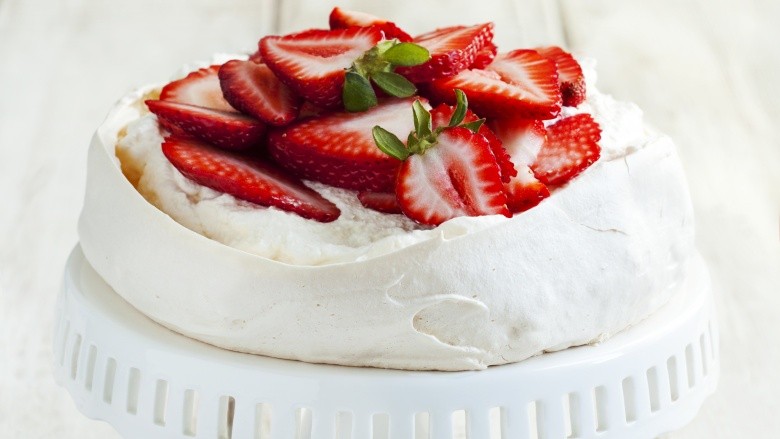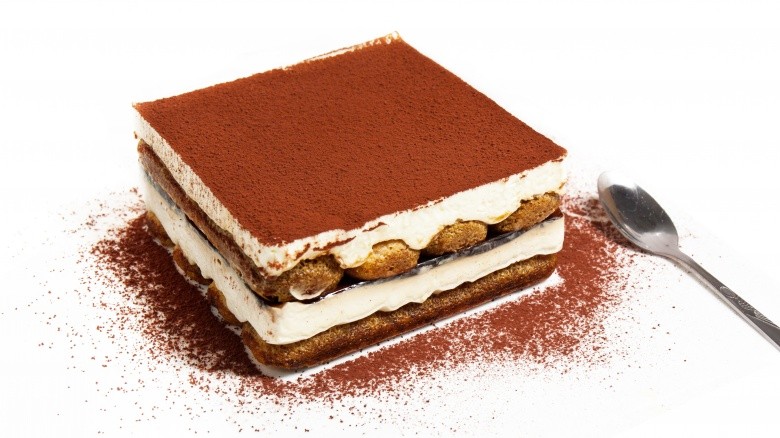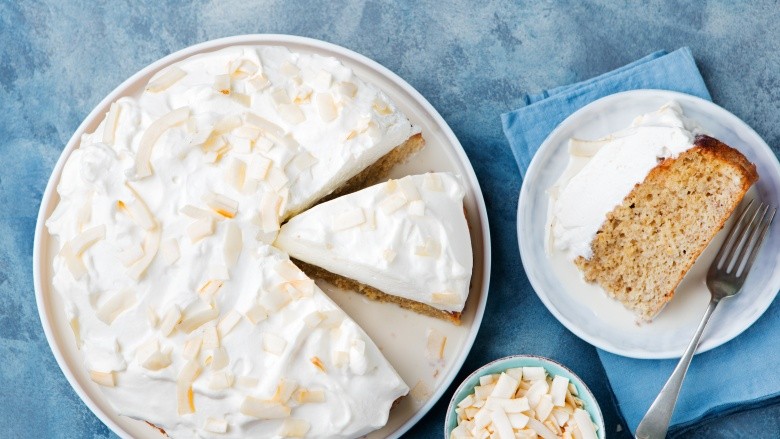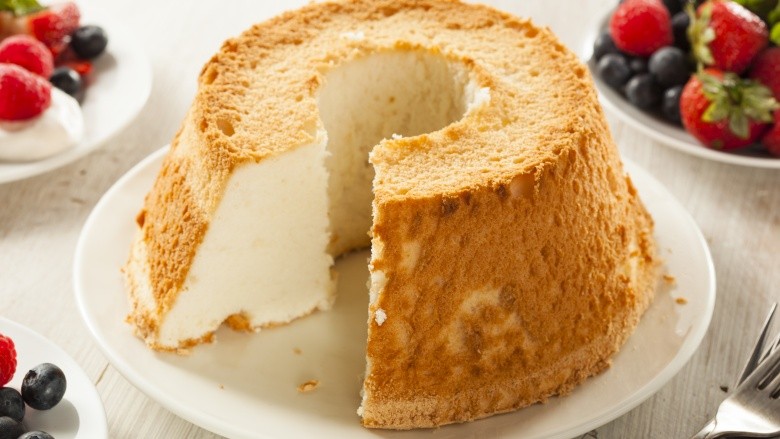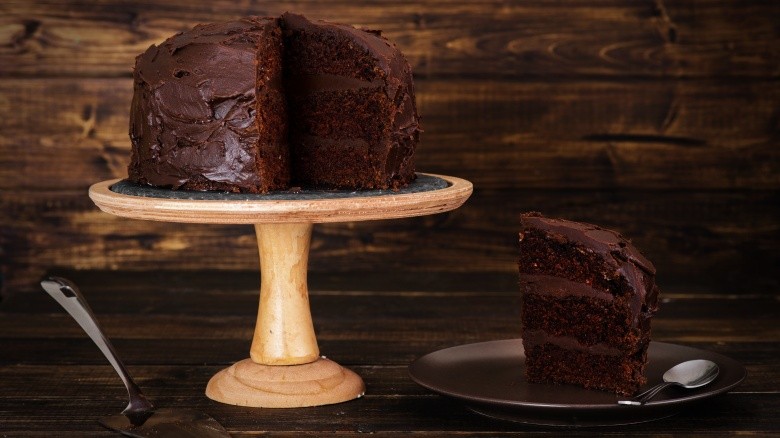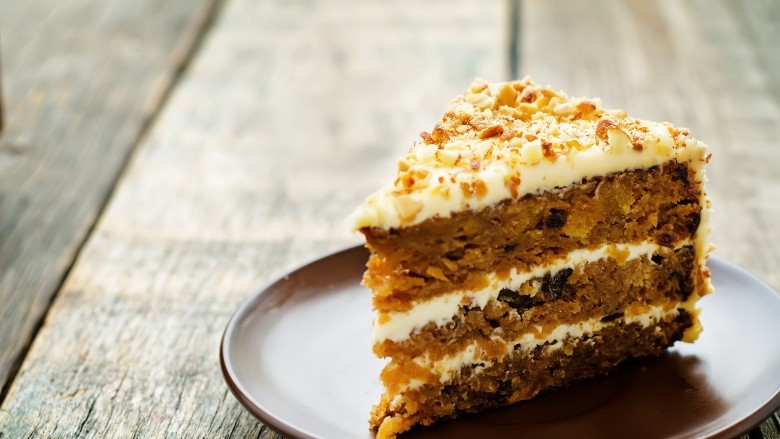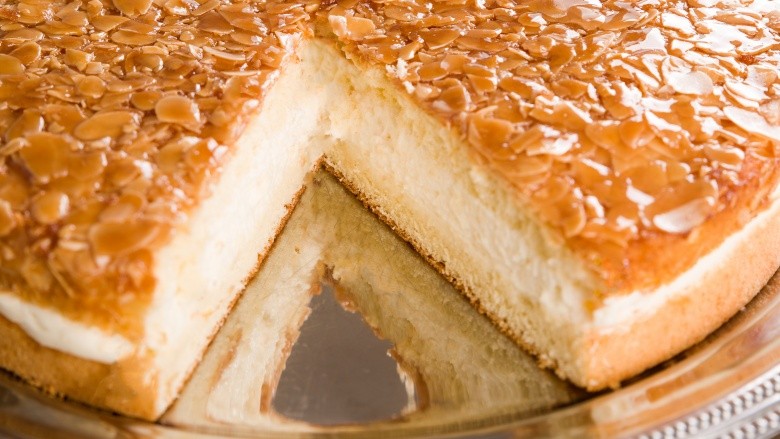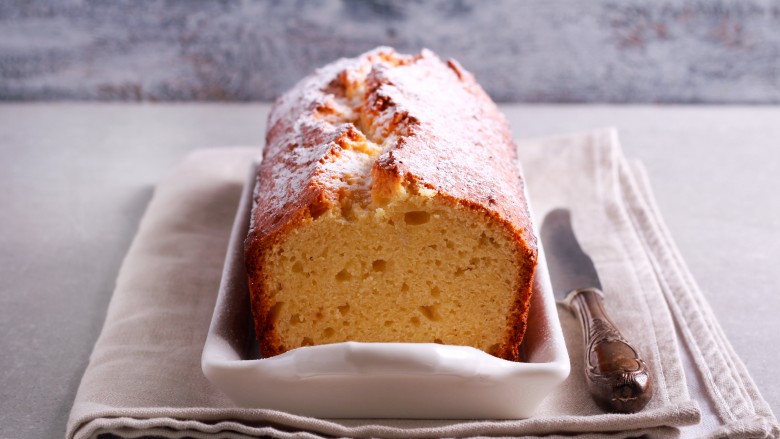10 Iconic Cakes Everyone Should Know How To Make
In the interest of full disclosure, I should tell you I take my top 10 lists pretty seriously. I have one for all the major and many minor categories — as in top 10 coming-of-age novels, top 10 tear jerker movies, top 10 American cities for eating desserts, you name it. Naturally, this obsession with categories and compiling lists means I have a pretty solid idea of what I believe to be the top 10 most iconic cakes everyone should know how to make, and now I'm going to share it with you.
Since it's always a good time to bake cake, getting yourself familiar with the most universally beloved ones means you're always prepared should the urge strike. Whatever the occasion, whipping up a classic cake with a reputation for pleasing the taste buds means you'll always be the most popular person in the room.
From German black forest and vibrant red velvet to weightless pavlova and coffee-infused tiramisu, get to know the archetypal cakes that make dessert dreams come true.
Black Forest cake
Black Forest cake is an instantly-recognizable German confection. Made with layers of impossibly moist chocolate sponge cake, cherries, and freshly whipped cream, this is what you make for someone you love dearly. A dense layer of chocolate shavings is used to garnish the outside of the cake, making it pretty hard to miss in a crowd.
Called "Schwarzderkirschtorte" in German — which is totally pronounceable — this famous cake is thought to have gotten its name from the tri-colored garb worn by women in the Black Forest region of Germany. The torte's chocolate sponge, cream icing, and cherries are believed to represent the black dress, white top, and red pom-pommed hats worn by the women. Sources remain disputed as to when the cake was actually invented. While Cafe Schaefer credits Josef Keller with its creation in 1915, other sources indicate a date of origin that goes as far back as the 16th century and as late as 1930.
Whatever the real origin of the cake, I thoroughly enjoy this version of it from Natasha's Kitchen. While there are many other recipes out there, this one results in a delectable Black Forest cake that resembles the classic version you might find on offer in Germany. Rich cake layers are emboldened by cocoa powder and baked to tender perfection. Kirsch-soaked cherries and lightly whipped cream balance the chocolatey flavor, while a layer of chocolate shavings are a stunning adornment.
Red velvet cake
Who can resist the siren's song—er, hue—of red velvet cake? I'm a sucker for the beautiful deep color of the cake and its tender crumb. This chocolatey-tasting cake is traditionally complemented with sweet, tangy cream cheese frosting for maximum wow effect. Whether you serve it for a birthday party, enjoy it in the form of a cupcake for portion control, or with a glass of milk alongside, there is no denying its powers of seduction.
These days, you can find red velvet cake smells, flavors, and essences everywhere. From scented candles and air fresheners, to coffees and liquor, the phenomenon is real. Despite the current commercial trend of red velvet, this soft cocoa-flavored cake has a real story. Its moist, fluffy texture is thought to be caused by the chemical reaction between its ingredients. Without artificial coloring, this cake is actually more of a deep mahogany, a hue caused when the buttermilk reacts with the acidic vinegar to reveal the natural red coloring in cocoa. While Northeasterners say the cake was invented at New York's Waldorf-Astoria in the 1950s, Southerners will tell you the dessert originated in the South during the American Civil War.
This recipe from Sally's Baking Addiction walks you through how to make a red velvet cake worthy of all the praise and admiration. The moist layers are boldly flavored with cocoa powder and deeply colored with food coloring. If you are averse to artificial coloring, feel free to use less or omit altogether. The cake will still taste on -point although its color will be closer to brown than red. To bring it all together, there's the irresistible icing. You'll love the classic tang of the cream cheese frosting and the clever garnish of cake crumbs on top, too.
Pavlova
As a big fan of the seemingly impossible weightlessness of crisp-on-the-outside-soft-on-the-inside meringue desserts, I can attest to the power of the pavlova. This airy confection is made using egg whites and sugar, then finished with whipped cream and an assortment of fresh berries or a sweet fruit compote. It's one of those things you start off eating one slice of, and end by polishing off the whole thing. That's the risk of enjoying a dessert so light that it just melts in your mouth.
According to Food52, both Australians and New Zealanders lay claim to inventing pavlova. While each disagree about where exactly the dessert was first created, they both concur it was named after the famous Russian ballerina, Anna Pavlova. You know, being a ballerina, she was light as air, er, meringue. Meringue is made by vigorously whipping egg whites until the mixture becomes glossy and then crispy on the exterior when baked. Due to its lightness, it makes perfect sense that the confection would be named after a seemingly weightless dancer.
This streamlined and easy-to-follow recipe from Ina Garten for the Food Network makes it so easy to whip up (haha) pavlova that you'll find yourself making it far too often. Egg whites are whipped with sugar, vanilla, and cornstarch, then baked low and slow for optimal results. The cooled pavlova is generously topped with whipped cream and sweet and tart heaps of homemade raspberry sauce.
Tiramisu
This popular Italian custard dessert is a true crowd pleaser — and for good reason. Think layers of ladyfingers dipped in coffee, flavored with cocoa, paired with whipped custard, and complemented by tangy mascarpone cheese. Would you turn that down? Chances are you've had a piece at a restaurant at some point, but if you've never made it, you're in for a treat. This labor of love is worth every minute in the kitchen.
With a name that means "pick-me-up" in Italian, espresso-infused tiramisu as we recognize it today first appeared in the early 1980s in Treviso, Italy. That said, according to The Kitchen Project, origins of the dessert's sponge cookie layer can be traced back to the early 15th century when savoiardi cookies—aka ladyfingers—were used to make other sweet concoctions such as trifles. Espresso, a key ingredient in tiramisu, didn't exist until the early 1900s.
This genius recipe for tiramisu comes from the folks at Epicurious, who have managed to make the multi-step process for creating the dessert as easy as possible. Here, it's all about the expert layering and pro flavoring throughout. Every bite is filled with layers of tangy mascarpone and whipped cream, a dusting of rich cocoa powder, spongy ladyfingers soaked in liquor-infused espresso.
Tres leches
Popular throughout Latin America, tres leches—or "three milks"—is a sweet and addictive sponge cake soaked in, you guessed it, three types of milk: condensed milk, evaporated milk, and whole milk or heavy cream. The airy holes in the cake allow it to soak the liquid without deteriorating into a soggy mess. Whether served with a layer of frosting and fruit garnishes on top or not, tres leches definitely belongs in the cake canon. It tastes like a celebration cake to me, but I could picture myself eating it on a random Tuesday night, too.
As with all delicious foods, various regions have claimed to be the originators. According to What's Cooking America, this popular dairy-laden cake was first created in Nicaragua, although others believe it only became popular in Central and South America after Nestle published the recipe on its cans of condensed milk. For all we know, the seedling for the cake's conception may have originated in Europe where the practice of soaking cakes (see tiramisu) had become common practice.
While there is no definitive recipe for tres leches as there is no consensus on where the cake came from, this version from Mexico in My Kitchen is a winner in my book. Here, the cake layer is made extra rich using butter and eggs, while the soaking liquid is a combination of condensed milk, evaporated milk, and heavy cream. The top is frosted with a light layer of freshly whipped cream. Although the recipe calls for garnishing the finished cake with canned fruits, I prefer using fresh cut fruits since they are less sugary. Your call.
Angel food cake
As much as I love butter, I am a big fan of butterless angel food cake, too. I know! It's a miracle. For this light and tender sponge cake, egg whites are whipped to stiff peaks and stabilized by a dash of cream of tartar. Remaining ingredients such as flour and sugar are gently folded into the egg mixture, so as not to deflate the airiness gained from rapid whipping. Even though this dessert sounds like a science experiment, it tastes like sweet perfection.
It is believed that angel food cake is connected to the biblical story of the bread called manna, consumed by angels in heaven. Since the texture of the cake is light and airy as a result of omitting butter, the treat is commonly associated with notions about angels and heaven. While angel food was first made in the United States in the 1800s, it didn't catch on until electric beaters made it easier to whisk eggs vigorously to incorporate air.
This recipe from King Arthur Flour results in a simple, traditional, and scrumptious angel food cake you'll find somewhat transporting. Incredibly versatile, this cake is as comfortable paired with fresh cut fruit as it is topped with sweetened whipped cream or dusted with cocoa powder. You deserve to eat angelic food every now and then.
Devil's food cake
This sinfully named dessert, devil's food cake, is one you'll want to get acquainted with if your love for chocolate is disproportionate to all other things. The opposite of angel food cake, this decadent treat often pairs rich, extra chocolatey cake layers with copious amounts of chocolate frosting. Think of it as the most exhilarating chocolate onslaught you can experience. This cake blows away the standard chocolate cake, as it it infinitely more moist, fluffier, and more luxurious in its unabashed cocoa glory.
While recipes for various types of chocolate cake can be found in cookbooks of the 1800s, none were called devil's food until the 1930s. As a distinct contrast to angel food cake and its light color and texture, this deeply indulgent cake was meant to be the devilish counterpart. As Jean Anderson puts it in her cookbook, American Century Cookbook, "Angel food belongs to the nineteenth century but devil's food to the twentieth."
This recipe from Williams-Sonoma's test kitchen encapsulates what is so delightfully sinful about devil's food cake. Natural cocoa powder makes these cake layers distinctly rich and deeply flavored. The use of boiling water in the batter enhances the chocolate flavor and makes for a ridiculously tender crumb. Frosted with sweet chocolate icing, this over-the-top cake is not for the faint of heart.
Carrot cake
Denser than sponge cake, carrot cake boasts delicate sweetness and a moist crumb. Shredded carrots are incorporated into the batter, rendering the baked cake tender as a result of the additional moisture during cooking. This rich, warmly spiced cake is often paired with thick, luxurious cream cheese frosting for a truly memorable dessert experience. The fact that it contains carrots is enough for me to categorize it as a health food and eat it every other day.
Carrot cake most likely began as carrot pudding consumed during the medieval time period. Later on, when sugar was hard to find during the Middle Ages, carrots were sometimes incorporated into dessert dishes for their natural sweetness. By the 1960s, carrot cake had gained in popularity in the States, making the sweetly spiced treat a mainstay of the home cook.
This recipe from Epicurious makes a classic carrot cake flavored with fragrant spices such as cinnamon, nutmeg, and allspice. Made rich by eggs and tender by carrots and brown sugar full of molasses, this cake is sure to win over the toughest critics. Buttery cream cheese frosting is slightly sweet and slightly tangy, making it the ideal icing for a complexly flavored cake like this one.
Bee sting cake
Bee sting cake—aka "bienenstich" in German—is notable for its soft yeast-leavened dough. Deliciously filled with a custard, pastry cream, or buttercream filling and finished with a sticky topping made with almonds, the cake's sweetness is said to attract bees!
While bee sting cake doesn't have a precise history to trace back to, this popular German cake is a classic in its home country for good reason. The traditional combination of pillowy yeasted cake dough, creamy vanilla custard filling, and caramelized almond-honey top makes this Bavarian specialty one worth exploring wherever you come from.
This version of the bee sting cake from Smitten Kitchen takes a minute to make, but you won't be sorry! I've made it a few times for various potlucks and dinner parties, and each time, it's been polished off before the night ended. The recipe is comprised of three parts: cake, topping, and filling. The subtly sweetened cake requires time to rise and bakes up soft and tender—a cross between cake and brioche. A crunchy topping is made using honey and almonds for warm flavor and delicious crackle. The filling is a simple but luxurious tasting vanilla and almond-infused pastry cream. The result? Perfection.
While there are countless more cakes out there for you to make, learning how to make these masterful beauties lets you conquer a wide variety of baking skills and enjoy eating a lot of cake. It's kind of a win-win situation, right?
Pound cake
Easy to make with only a few pantry ingredients, pound cake is one you should learn how to make for those afternoons when you simply want cake and there is no occasion. It's something sweet, buttery, and delicious that you whip up sans recipe if you're so inclined. Made with butter, flour, eggs, and sugar, this cake is lovely served with tea, delightful on the run, and a pleasure to enjoy on its own.
Pound cake gets its name from the traditional amounts of ingredients used in its making: 1 pound each of butter, flour, eggs, and sugar. Yes, it's that simple! The initial recipe for this rustic sweet dates back to the 18th century, although today you'll find hundreds upon hundreds of recipes with variations far and wide. From leavening and citrus zest to chocolate and icings, the additions are endless. Like basic yellow or white cakes, pound cake is infinitely adaptable to suit your tastes.
While it's fun to make pound cake without a recipe on hand, I offer this one just in case you're the type who prefers to look at something. This one from homemaking queen Martha Stewart is a good starting point since it sticks closely to the original 1-pound makeup. That said, do feel free to add your favorite flavorings and any other extras that would make this cake truly your own.
